Who's on first: tesla or chrysler?
who’s on first: tesla or chrysler? who was first usa automaker to fully repay government loan? via washington post [RK]
who’s on first: tesla or chrysler? who was first usa automaker to fully repay government loan? via washington post [RK]

tesla pays off its loan. wired $451.8 million to repay the full loan with interest. via washington post [RK]
Full Circle, has been selected to screen in Holland at Gemeetemuseum Den Haag’s Summer Expo: EARTH, 8 June > 15 September. Have a well-rounded EARTH DAY. Thanks. [ Tom ]

above> synapse
DesignApplause is talking to Argentinian designer Francisco Gomez Paz and US CEO of Luceplan, Giuseppe Butti, in the Miami Luminaire Design Lab Showroom. We’re all here for Design Miami 2012 and these men are here to introduce Francisco’s new light ‘Synapse’ to the US. It’s all part of Luminaire’s annual presentation of new production introductions during DesignMiami.
[DesignApplause] What brings the both of you here here?
[Francisco Gomez Paz] We’re here because Luminaire wishes to introduce a new product that I designed for Luceplan, the Synapse light. A system that works with LED light. It’s basically a divider of spaces. You can join it in different ways to create different configurations. Energy dividers for the space.
[DA] Is this a new product for 2012?
[FGP] We’re ready to put it on the market and we’re showing it here for the first time in America.
[DA] Francisco, tell us a little about you and where’s your design office located and what’s your office like?
[FGP] I’m Argentinian, born in Argentina. I studied in Argentina, but moved to Italy 14 years ago to study the Master in Design at Domus Academy. After a bit of working experience, I opened my office. Now I’m working with several companies.
[DA] The LED technology is causing quite a stir in the U.S. We’re starting to do away with the incandescent light bulb. In Europe, you have a bit of a head start on this.
[Giuseppe Butti] Yes. Europe banned the incandescent bulbs a year ago. The move is coming to the U.S. as well. The prime mover is the West coast with all their energy codes. The LED really started nudging out the halogen and incandescent bulb a few years ago with Title 20 or Title 24. This past year we saw a big trend toward the new light sources, like LEDs for commercial spaces, replacing florescent light sources. At residential levels, incandescent is still the most popular light source that people prefer.
[DA] People are hoarding incandescent light bulbs now.
[GB] I know. But the residential sector is starting to understand the LED a little bit better. The more it evolves toward a warmer light, away from the blue LED lights we used to see in the beginning, the more people are getting comfortable with adding new light sources in their homes.
[DA] I know the earlier LEDs were very unpredictable and unreliable. How long ago were you able to begin to invest in making quality lights?
[GB] I think that Luceplan, was one of the first companies to start experimenting in 2003-2004 with LED lights. We came out with the first LED product in 2006 called “Mix.” Since then, the entire industry has seen a big evolution. And our company now belongs to Philips which is one of the key producers of LED in the world. All our designers, like Francisco, take advantage of the R&D Development that we have. Every year we the LED technology allows us to do more than before. This is the big thing. It’s very important.
[Francisco Gomez Paz] In terms of design, I think it’s a big opportunity to try to find new languages. Then we can change all the earlier rules concerning sources of light. In my opinion, it’s a very nice opportunity to find new types of lights.
[DA] What are some of the differences from a design point of view that LED brings to you?
[FGP] There are huge differences. One is the light, the lamp, is a really tiny electronic element, not electric element, and is very small. 4×4 millimeters. It’s allowing us to put it in different types of situations that wasn’t possible before using the E27 lightbulb. It’s really amazing in terms of design. Luceplan encourages me to experiment to find new objects and new technology. Predictably there are many companies simply copying what was done before. That’s a big missed opportunity for many. Our decision is to try to imagine new frontiers of light.
[DA] How was the light conceived? Who approached who?
[FGP] This is an idea that came to me because one of the sources of inspiration a designer and an architect can have is to understand the human being. How you live and change. Of course, in the last 20 years, you have smaller houses and you remove walls because you need bigger spaces, for example it’s really common to mix the kitchen with the living room to share activities. But you still need in some cases sort of divider or filter. Hence the starting point for this idea. I tried to create a new way to divide spaces using light, LED light. I then simplified the idea using just one shape, a module, that could be configured in many interesting ways.
[DA] What are the materials used?
[FGP] Polycarbonate.
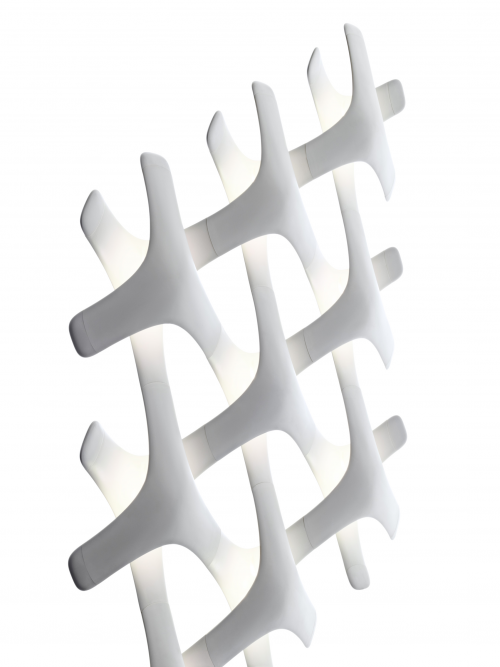 synapse
synapse
[DA] Looking at what you have on the wall, how many modules are up there?
[FGP] I know this may sound silly, I designed the assembly, but from here I can’t tell. I have to get closer to see a few seams then I can tell you.
[DA] How heavy is a module?
[FGP] They’re really light. We designed it wanting a lightweight solution and we used the minimum amount of plastic possible. Just two very light pieces of plastic that are welded together.
[DA] You had an idea. You go to Luceplan. Then you begin to collaborate with their engineers.
[FGP] Yes. I have a very good six-year relationship with Luceplan. We started with the Hope chandelier and we put to market in 2009 in Europe and 2010 here. It’s now a best seller at Luceplan and has allowed us to have a really good trusting relationship. I work almost in-house with the Luceplan engineers plus it spills over to my studio and workshop. Prototypes can be made at Luceplan or my office. A very open dialogue. That’s something really special of a relationship with Italian companies. That there’s such a close dialogue with a design company. A very open and free one.
[DA] We’re very fortunate having both the designer and the US CEO here. A business question: What percentage of your products are in the US and around the world?
[GB] The U.S. represents about 15% of total sales of Luceplan.
[DA] How long have you been in the U.S.?
[GB] Seven years in the US Before that I worked for 5 years for Luceplan in Milan as a sales and marketing director. We’ve been in the US since 1994, and it’s a long-term commitment. We are based in New York and New Jersey. We have a showroom in Soho. We have warehouses and corporate offices just outside of the city. However, the majority of the markets are the European markets. The most important markets are Germany, Italy, Scandinavia.
[DA] Luceplan is positioned as both contract and residential?
[GB] Yes, absolutely. The Luceplan line is for both markets. I would say that overall, we have about 65-70% is contract and the rest is residential. I must say that this percentage, which is quite unusual for Luceplan, is mainly due to the fact that the distribution of high-end lighting or high-end furniture stores in the US is not so wide. It’s not easy to find retail stores that can sell high-end products. This is a bit of a limit of the U.S. distribution. Certainly in the U.S. we are mainly contract oriented as far as retail.
[DA] Which are some of the U.S. cities you feel have a lot of potential?
[GB] The Northeast certainly. It’s one of our biggest markets. So is Miami. Mainly because there are a lot of South Americans and Europeans here that have bought apartments and houses and are almost residents here. The South American and European culture is very strong in Miami. The Northeast, Miami and then Canada. Southern California is another key market.
[DA] Francisco, do you just design lighting? It seems that there are so many architects doing products and vice versa.
[FGP] I do all kinds of products, not just lighting. My clients are mainly in Italy. I have a new client in America. As a designer, I’m very holistic in using different kinds of materials and means of creation for objects.
[DA] You’re strictly a product designer, not an architect? It seems in Europe there are many architects doing products and vice versa.
[FGP] I’m not an architect, even if I came from a family of them. Sometimes I’ll do some things for myself, but no I’m not. I think the same philosophies share something that is difficult to divide.
[DA] Where did you go to school?
[FGP] At the “Universidad Nacional de Cordoba” in Argentina, that is one of the oldest university of Argentina. After that I achieved a master at Domus Accademy in Milan.
[DA] What do you think of Design Miami?
[FGP] You have two different things going on in the city. The art show and the design show. The design show has matured and grown in importance attracting more people to talk about design.
[GB] Luceplan presented ‘Hope’ at Luminaire in 2010 and it was a big success. We’re presenting again tonight, introducing Synops to North America and hoping for the same kind of success.
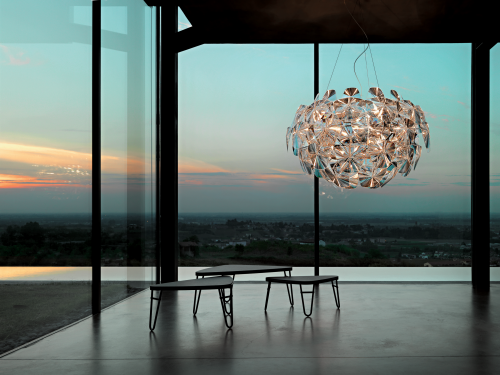 hope
hope
[DA] Francisco, do you do limited edition pieces for the design galleries? or are you just concentrated on production?
[FGP] For now I concentrate just on production.
[DA] What does that mean ‘now?’
[FGP] My interest in the past was doing high production pieces because of the investment that went into the objects. There was more opportunity to experiment. Today’s technology is making it possible to experiment with small production with very good quality and that will encourage designers to participate because of the allure the freedom to experiment.
[DA] Tell us about your design principles? Do green and sustainable go into it?
[FGP] We can talk a long time about this. I don’t think you can put an eco label to design because I believe that it’s something that has always been in the philosophy of design. It’s impossible not think pollution and energy consumption. My philosophy is best described knowing the shape never starts in the beginning. I always try to start from a white paper free of preconceptions of ideas or shapes. For me, a shape is already an idea that is closed. My process is long, it involves philosophy, technology and the freedom to change the pre-existing. In the end of this process the shape almost magically appears.
[DA] Giuseppe, are you selling online?
[GB] We do online sales because in the US it’s very difficult not to do them. But it’s not the majority of our sales. The majority is the contract business or with architects on projects. Hospitality. Commercial. Residential. We have a network of retail stores like Luminaire and many others, but selective. Online is for us about 10% of our sales.
[DA] Do you have any stand-alone Luceplan retail stores in any city?
[GB] We have one in New York. In the heart of Soho. It’s our flagship store. So far this is the only one. It’s been open since 2007. Prior to that we had another showroom that was less a retail store, but more a showroom still in the Soho neighborhood on Houston Street and then we moved the our current location on Green Street.
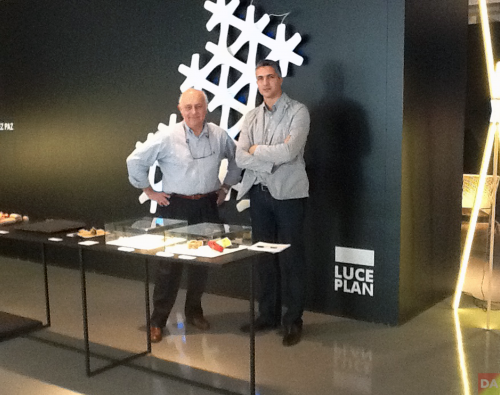 giuseppe and francisco
giuseppe and francisco
[DA] How successful is it? Everyone I talk to in your business niche, the jury’s out for many. How is it working for you?
[GB] It’s good. It’s working. It’s still our number-one retail store in terms of sales. Certainly, with the New York costs, you have to see it as an overall advertising touchpoint for Luceplan worldwide. A lot of people from all over the world pass through Soho which is great for our brand image.
Another thing, our store in New York is more than a retail store, it’s also a showroom. We use that space to present to architects and designers. We organize events. For us, it works both ways. It’s yes on one side, a retail store so you can come in and buy a fixture. On the other side, it’s a moment that we use to present, in an ideal situation, a light fixture to an architect. You walk into stores where it’s difficult to figure out what that fixture can really give you. In our store, we pretend to say we have ideal vignettes and situations for our fixtures. We are happy with our store.
[DA] What’s Luceplan’s philosophy? Do you have an in-house design group?
[GB] Two of the founders are Paolo Rizzatto and Alberto Meda. They founded the company and are still designing for us. We also go to Francisco and many others from France, Italy, the US and all over the world. The important thing for us is that we receive a lot of proposals for new products and then it goes through a selection. If we think it is in line with the overall general philosophy, we are certainly open to new ideas and new products. We like to always been innovative not only with the materials, but also in the idea.
[DA] What is your background? Are you a businessman or are you a creative?
[GB] I’m strictly a business person. But I love design. I’ll let you alone with Francisco now.
[DA] Francisco, is there anything else you want to say that we have touched?
[FGP] I’d like to emphasize a really good relationship with Luceplan because we share many philosophies, and important ingredient. We like to do innovative things, but not just to do them. Design is an amazing tool to make a little progression to the world. Even in small pieces. Innovation always puts new value into our lives. That’s the role of design. You try to understand everything. Technology. Human beings. You try to do that little innovation step-by-step. That way we continue to innovate. This sharing of philosophy, the beautiful relationship we have with Luceplan…we’ve discussed many times where this world is going and how we can give to this world new objects that solve problems and that improve our lives in little steps.
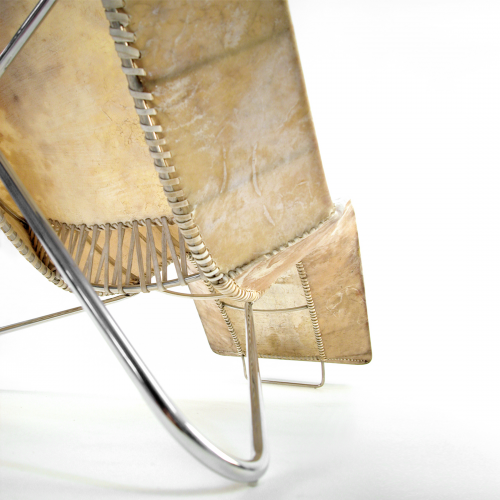 apero
apero
[DA] Early-on in my interviews I used the label ‘design-driven’ objects. I felt compelled to use this label every time interviewing non-designers. A non-designer response almost always was ‘function-driven’ along with a well-thought out explanation.
[FGP] I would say idea-driven. An idea includes functions, materials and human beings. When philosophy is true to design, it transforms into something that is solid and original. What moves me are the ideas and then everything comes.
[DA] Your work is very clean. The architect Jon Ronan who’s work is also clean describes his work as ‘essential’ where he subtracts until he gets to the piece that is essential, that when you take that piece away the idea is broken. Can you describe your aesthetic?
[FGP] I cannot put myself in one aesthetic movement. Ideas can be expressed in completely different ways. There are things that are minimal and things that deserve more complexity.
I mean, it’s not something that I think of when I’m doing a project. If you see some of my designs, you will see lots of complexity but also at the same time, simplicity. My thinking is not so simple. Sometimes I love complexity. Nature is full of complexity. A tree is full of art and intelligence. I enjoy the intelligence of something and work with it. I don’t have any kind of preconception. If you take everything from a tree, what will you have? A tree is really complex. Even when it’s blooming, it’s full of flowers. Not just one. I love the freedom of nature, to be simple or complex. Depends on what you are trying to do.
[ francisco gomez paz ] [ luceplan ] [ luminaire ]
1/4> synapse | fgp | 2011
5/11> hope | fgp | | luceplan | 2010
12> nothing | fgp | luceplan | 2012
13> comodoro | fgp | danese | 2008
14> solar bottle | alberto meda and fgp | 2007
15> omero | fgp | driade |2006
16> ovidio | fgp | danese | 2005
17/18> apero | fgp | sumampa | 2004
19> otto watt | alberto meda | luceplan | 2011
20> petale | odile dec1 | luceplan | 2011
21> honeycomb | | habits studio | luceplan |2011
22> archetype | good morning technologies | luceplan | 2010
23> any | habits studio | luceplan | 2010
applications due friday, 15 february!
Moving Design is a coalition of designers and artists, working with community partners, leading initiatives that inspire change through the power of design.
Our 2013 Call to Action is focused on informing and transforming Sustainable Living in Chicago’s West Loop neighborhood. We will select fifteen designers, writers, programmers, and visionaries to generate powerful ideas and become catalysts for smarter, more sustainable living choices. Inspired by the WPA’s simple, strong illustrations and messages, we’ll introduce the neighborhood to ideas and initiatives which will inspire community actions. [ details / apply now ] @movingdesign fb/movingdesign
the greening of mardi gras. making epic cavalcade of debauchery a bit greener, starting with the beads. via grist [RK]
 click > enlarge
click > enlarge
We’re beginning to see more folding bikes on the streets but there aren’t many, if any, electric bikes like this one. It doesn’t even look electric. A exclusive design, patented by BH, makes the NEO a stylish and attractive bicycle that conceals a powerful battery in its frame with a range of up to 55 miles/90 km. Thanks to its accelerator, it allows riding at 10 moh/6 km/h without having to pedal or speeds up to 27 mph/45km/h.

An innovative 20″ folding mechanism allows this bike to shorten the frame to facilitate entry to elevators, and all kinds of public transportation. There’s also a second folding position for car boot storage.

Equipped with Telescopic, Shimano and Suntour brake and powertrain and Kenda antipuncture reflex tires. Extras include a GPS anti-theft system, a mobile app that can communicate with your mobile telephone by installing a Bluetooth device instead of the LCD display screen, light upgrade kits. You can choose from four types of progressive assistance until reaching a 1:3 assistance ratio (user effort: motor effort) The pedal assistance selection is carried out by means of an intuitive and completely extractable LCD display located on the handlebar. Designed by Item Desarrollo de Producto for Easy motion by BH. [ bh bike ] [ item desarrollo de producto ]
 click > enlarge
click > enlarge
Here’s a win-win-w1n solution for safety, keeping the weight and gizmos to a minimum, and looking cool. Epic Bike has embedded five LED lights into a seat post. Water-resistant and theft-resistant (with a little common sense) lights that last a minimum of 50 hours on two AA batteries. [ epic bike ]
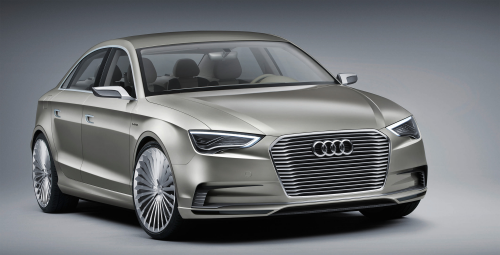 click > enlarge
click > enlarge
One of its most innovative features two steering wheel-mounted paddle shifters which control the intensiveness of regenerative braking. The E-tron is custom-fit with an electric motor and a pair of lithium-ion battery packs, which allows for 134 horsepower and 199 pound-feet of torque. The batteries themselves hold 26.5 kilowatt-hours of energy. Its driver may choose from one of several driving modes (Efficient, Normal, or Sport.) It also features a roomy interior and big, clean graphics on its exterior. Currently, this vehicle is a prototype and only a dozen or so are being driven within Audi throughout North America. Audi is planning to introduce the third-generation A3 to the States in 2014.
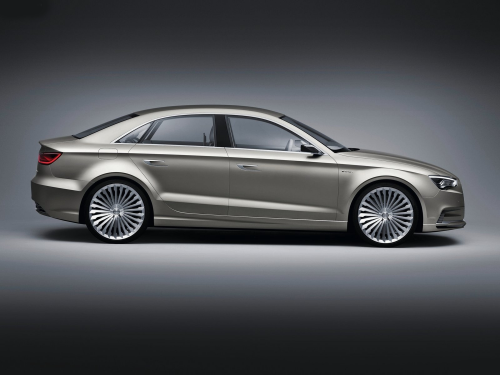
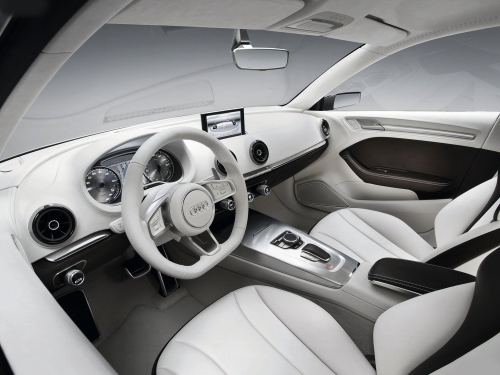
producer: audi
period: 2013
house forms caucus to raise federal energy efficiency. there is nearly 3 billion square feet of building space that’s owned and operated by the federal government. via green biz [RK]
All content ©2007 > 2024 DesignApplause
Notifications